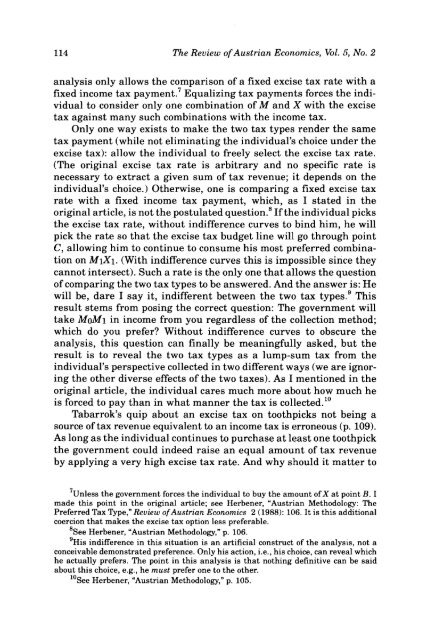Review of Austrian Economics - The Ludwig von Mises Institute
Review of Austrian Economics - The Ludwig von Mises Institute
Review of Austrian Economics - The Ludwig von Mises Institute
You also want an ePaper? Increase the reach of your titles
YUMPU automatically turns print PDFs into web optimized ePapers that Google loves.
114 <strong>The</strong> <strong>Review</strong> <strong>of</strong> <strong>Austrian</strong> <strong>Economics</strong>, Vol. 5, No. 2<br />
analysis only allows the comparison <strong>of</strong> a fixed excise tax rate with a<br />
fixed income tax payment. 7 Equalizing tax payments forces the individual<br />
to consider only one combination <strong>of</strong> M and X with the excise<br />
tax against many such combinations with the income tax.<br />
Only one way exists to make the two tax types render the same<br />
tax payment (while not eliminating the individual's choice under the<br />
excise tax): allow the individual to freely select the excise tax rate.<br />
(<strong>The</strong> original excise tax rate is arbitrary and no specific rate is<br />
necessary to extract a given sum <strong>of</strong> tax revenue; it depends on the<br />
individual's choice.) Otherwise, one is comparing a fixed excise tax<br />
rate with a fixed income tax payment, which, as I stated in the<br />
original article, is not the postulated question. 8 If the individual picks<br />
the excise tax rate, without indifference curves to bind him, he will<br />
pick the rate so that the excise tax budget line will go through point<br />
C, allowing him to continue to consume his most preferred combination<br />
on M\X\. (With indifference curves this is impossible since they<br />
cannot intersect). Such a rate is the only one that allows the question<br />
<strong>of</strong> comparing the two tax types to be answered. And the answer is: He<br />
will be, dare I say it, indifferent between the two tax types. 9 This<br />
result stems from posing the correct question: <strong>The</strong> government will<br />
take MQM\ in income from you regardless <strong>of</strong> the collection method;<br />
which do you prefer? Without indifference curves to obscure the<br />
analysis, this question can finally be meaningfully asked, but the<br />
result is to reveal the two tax types as a lump-sum tax from the<br />
individual's perspective collected in two different ways (we are ignoring<br />
the other diverse effects <strong>of</strong> the two taxes). As I mentioned in the<br />
original article, the individual cares much more about how much he<br />
is forced to pay than in what manner the tax is collected. 10<br />
Tabarrok's quip about an excise tax on toothpicks not being a<br />
source <strong>of</strong> tax revenue equivalent to an income tax is erroneous (p. 109).<br />
As long as the individual continues to purchase at least one toothpick<br />
the government could indeed raise an equal amount <strong>of</strong> tax revenue<br />
by applying a very high excise tax rate. And why should it matter to<br />
7 Unless the government forces the individual to buy the amount <strong>of</strong> X at point B. I<br />
made this point in the original article; see Herbener, "<strong>Austrian</strong> Methodology: <strong>The</strong><br />
Preferred Tax Type," <strong>Review</strong> <strong>of</strong> <strong>Austrian</strong> <strong>Economics</strong> 2 (1988): 106. It is this additional<br />
coercion that makes the excise tax option less preferable.<br />
8 See Herbener, "<strong>Austrian</strong> Methodology," p. 106.<br />
9 His indifference in this situation is an artificial construct <strong>of</strong> the analysis, not a<br />
conceivable demonstrated preference. Only his action, i.e., his choice, can reveal which<br />
he actually prefers. <strong>The</strong> point in this analysis is that nothing definitive can be said<br />
about this choice, e.g., he must prefer one to the other.<br />
10 See Herbener, "<strong>Austrian</strong> Methodology," p. 105.

















